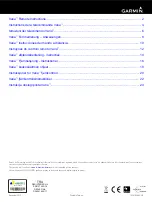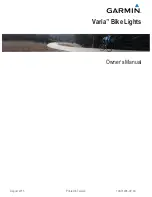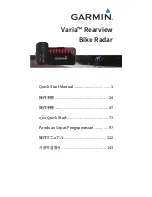
Bit Function
7:0 0x00: Use RAM storage only.
0x11: Use FLASH/NVM storage. Any register that supports both
read and write operations is stored in NVM and persists over
power cycles.
NOTE:
Use caution when enabling flash storage. The total number
of writes and erases is limited to 10,000.
0xEB
R/W Name
Description
Initial Value
R/W HIGH_ACCURACY_MODE Improved accuracy
setting
0x14
Bit Function
7:0 0x00: Disable high accuracy mode. While high accuracy mode is
disabled, you can adjust the POWER_MODE to
Asynchronous
Mode
or
Synchronous Mode
).
0x01 to 0xFF: Enable high accuracy mode. The value is used as
the number of distance measurements to accumulate and average
before returning them to the user. You must set the
POWER_MODE to
Always On
before you adjust to a non-zero
value.
0xEC
R/W Name
Description
Initial Value
R
SOC_TEMPERATURE
SoC temperature
--
Bit Function
7:0 Returns the temperature of the nRF SoC as an 8-bit, two's
complement value in Celsius.
Appendix
Reprogramming the nRF52840 SoC
NOTICE
Reprogramming the nRF52840 System on Chip (SoC) removes
all pre-programmed factory software. The device comes
preprogrammed with a unique ANT ID to ensure each device
can be uniquely identified over the ANT wireless protocol. When
reprogramming the device, special precautions should be taken
to preserve the ANT ID value. See
information about accessing and retaining the ANT ID value.
The LIDAR-Lite v4 LED device comes preprogrammed from the
factory with a Bluetooth LE secure DFU bootloader for receiving
wireless software updates. When reprogramming the
nRF52840, the bootloader is removed. If you require a
bootloader after reprogramming the device, you can follow the
Bluetooth LE Secure DFU Bootloader reference design in the
Nordic nRF5 SDK. If a boot pin is required, you should configure
it to one of the exposed GPIOs (
).
Before you can reprogram the device, you must connect it to a
compatible debugging probe.
The header on the LIDAR-Lite v4 LED device provides access
to the nRF52840 SoC. You can reprogram the nRF52840 SoC
to suit the individual needs of your project. Software
development should be completed using the C programming
language and the Nordic nRF5 SDK. For more information about
the capabilities of the nRF52840, go to
.
• For information about setting up a LIDAR-Lite v4 LED
development environment, go to
• For support in using the nRF5 SDK and reprogramming the
https://devzone.nordicsemi.com/
10-pin J-Link Wiring
You should connect the 10-pin J-Link debugging probe to the
LIDAR-Lite v4 LED device as shown in the diagram and table
below.
NOTE:
A 10-pin J-link debugging probe cannot supply power to
the LIDAR-Lite v4 LED device. Connections 1 and 2 are
connected to the device from an external power supply. The
power supply and debugging probe should share a common
ground at pin 2 on the LIDAR-Lite v4 LED device.
Connection 10-Pin J-Link Debugging
Probe Pin
LIDAR-Lite v4 LED Pin
--
2 (GND) to common ground
--
1 (VIN) to power source
3 (GND) to common ground --
1 (VCC)
7 (VRETURN)
10 (nRESET)
8 (nRESET)
2 (SWDIO)
10 (SWDIO)
4 (SWCLK)
9 (SWCLK)
20-pin J-Link Wiring
You should connect the 20-pin J-Link debugging probe to the
LIDAR-Lite v4 LED as shown in the diagram and table below.
Connection 20-Pin J-Link Debugging
Probe Pin
LIDAR-Lite v4 LED Pin
7 (SWDIO)
10 (SWDIO)
1 (VCC)
7 (VRETURN)
20 (GND)
2 (GND)
15 (nRESET)
8 (nRESET)
19 (5V Supply)
1 (5V)
9 (SWCLK)
9 (SWCLK)
Short 11 to 12
Not applicable
8




























